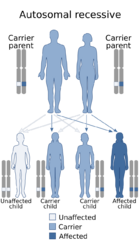Biology:Junior blood group system
| ABCG2 (Junior blood group antigen) | |
|---|---|
| Identifiers | |
| Symbol | ABCG2 |
| NCBI gene | 9429 |
| HGNC | 74 |
| OMIM | 614490 |
| UniProt | Q9UNQ0 |
| Other data | |
| Locus | Chr. 4 q22.1 |
The Junior blood group system (or JR) is a human blood group defined by the presence or absence of the Jr(a) antigen, a high-frequency antigen that is found on the red blood cells of most individuals.[1] People with the rare Jr(a) negative blood type can develop anti-Jr(a) antibodies, which may cause transfusion reactions and hemolytic disease of the newborn on subsequent exposures. Jr(a) negative blood is most common in people of Japanese heritage.[2]
Genetics

The gene ABCG2, located on chromosome 4q22.1, encodes an ATP-binding cassette transporter protein that carries the Jr(a) antigen. The Jr(a) negative blood type is inherited in an autosomal recessive manner: individuals who are homozygous for a null mutation of ABCG2 express this phenotype.[1] Homozygosity for certain missense mutations, or heterozygosity for a missense mutation and a null mutation, can result in a weak phenotype with decreased expression of Jr(a) antigen.[2][3] As of 2018, over 25 null and weak alleles of ABCG2 have been described.[4]
Epidemiology
The highest rates of the Jr(a) negative blood type have been reported in Japan,[5] where its prevalence ranges from 1 in 60 in the Niigata region to 1 in 3800 in the Tokyo region.[1] Additionally, a number of cases have been documented in European Romani populations.[6] The Jr(a) negative blood type is very rare in America: a study of 9,545 Americans failed to identify any Jr(a) negative individuals.[5]
Clinical significance
Anti-Jr(a) antibodies are generally composed of Immunoglobulin G and develop when individuals are exposed to Jr(a) positive blood through pregnancy or blood transfusion. Some cases of anti-Jr(a) have been reported in patients who have not been previously transfused or pregnant.[2][5]
Jr(a) is more strongly expressed on cord blood cells than on adult red blood cells,[4] and anti-Jr(a) has been reported to cause hemolytic disease of the newborn (HDN),[2] including fatal cases of HDN.[5][7] The antibody has also been implicated in delayed hemolytic transfusion reactions.[2] However, the clinical significance of the antibody is variable: in some cases, individuals with anti-Jr(a) have been transfused with Jr(a) positive blood or given birth to Jr(a) positive babies without incident. It is recommended to transfuse individuals with anti-Jr(a) with Jr(a) negative blood if the antibody titer is high. In other cases, "least incompatible" blood (the blood unit that gives the weakest reactions during crossmatching) may be suitable.[5][4] It is difficult to secure Jr(a) negative donor blood due to the rarity of this blood type.[6]
ABCG2 is a uric acid transporter, and the Jr(a) negative phenotype is associated with gout in Japanese populations.[8]
Laboratory testing
An individual's Junior blood type can be determined by serologic testing, which uses a monoclonal antibody reagent directed against the Jr(a) antigen.[6] DNA testing may be impractical due to the high number of mutations affecting Jr(a) expression.[9]
Anti-Jr(a) antibodies are most easily detected by the indirect antiglobulin test, and their reactivity is enhanced by enzyme treatment with ficin or papain.[2]
History
The Junior blood group system was discovered in 1970 by researchers Stroup and MacIllroy, who reported on five patients whose blood was incompatible with all samples tested except each other's. They named the causative antigen "JR" after Rose Jacobs, one of the five patients — the common name "Junior" is in fact a misnomer.[2]
In 2012, two research groups[6][10] independently identified ABCG2 as the basis of the Junior blood group system. The Junior system was officially designated a blood group by the International Society of Blood Transfusion that year.[11]
References
- ↑ 1.0 1.1 1.2 "OMIM entry # 614490 – Blood Group, Junior System, Jr". Online Mendelian Inheritance in Man. 2013. https://www.omim.org/entry/614490.
- ↑ 2.0 2.1 2.2 2.3 2.4 2.5 2.6 "A review of the JR blood group system". Immunohematology 29 (2): 63–8. 2019. doi:10.21307/immunohematology-2019-126. PMID 24094238.
- ↑ "The JR blood group system: identification of alleles that alter expression". Transfusion 53 (11): 2710–4. November 2013. doi:10.1111/trf.12118. PMID 23438071.
- ↑ 4.0 4.1 4.2 "Clinical significance of antibodies to antigens in the Raph, John Milton Hagen, I, Globoside, Gill, Rh-associated glycoprotein, FORS, JR, LAN, Vel, CD59, and Augustine blood group systems". Immunohematology 34 (3): 85–90. 2019. doi:10.21307/immunohematology-2018-013. PMID 30295501. http://www.milaisu.com/wp-content/uploads/2019/05/34_3_85-90-Moghaddam.pdf.
- ↑ 5.0 5.1 5.2 5.3 5.4 Daniels, Geoff (2013). "Chapter 27: The Junior and Langereis blood group systems". Human Blood Groups (3rd ed.). West Sussex, UK: John Wiley & Sons. pp. 487–9. ISBN 978-1-118-49354-0. https://books.google.com/books?id=CHT_-c45qQcC&pg=PT601.
- ↑ 6.0 6.1 6.2 6.3 "Null alleles of ABCG2 encoding the breast cancer resistance protein define the new blood group system Junior". Nature Genetics 44 (2): 174–7. January 2012. doi:10.1038/ng.1070. PMID 22246505.
- ↑ "Fatal hemolytic disease of the fetus and newborn caused by anti-Jra antibody: A case report and literature review". Transfusion and Apheresis Science 59 (1): 102605. July 2019. doi:10.1016/j.transci.2019.06.029. PMID 31324575.
- ↑ Silberstein, Leslie E.; Anastasi, John (14 June 2017). "Part XI: Transfusion medicine". Hematology: Basic Principles and Practice E-Book (7th ed.). Elsevier Health Sciences. p. 1700. ISBN 978-0-323-50971-8. https://books.google.com/books?id=tNcoDwAAQBAJ&pg=PA1700.
- ↑ "Molecular analysis of immunized Jr(a-) or Lan- patients and validation of a high-throughput genotyping assay to screen blood donors for Jr(a-) and Lan- phenotypes". Transfusion 54 (7): 1836–46. July 2014. doi:10.1111/trf.12544. PMID 24456066.
- ↑ "ABCG2 null alleles define the Jr(a-) blood group phenotype". Nature Genetics 44 (2): 131–2. January 2012. doi:10.1038/ng.1075. PMID 22246507.
- ↑ "Five new blood group systems - what next?". ISBT Science Series 9 (1): 136–140. 2014. doi:10.1111/voxs.12078. ISSN 1751-2816.
 |

